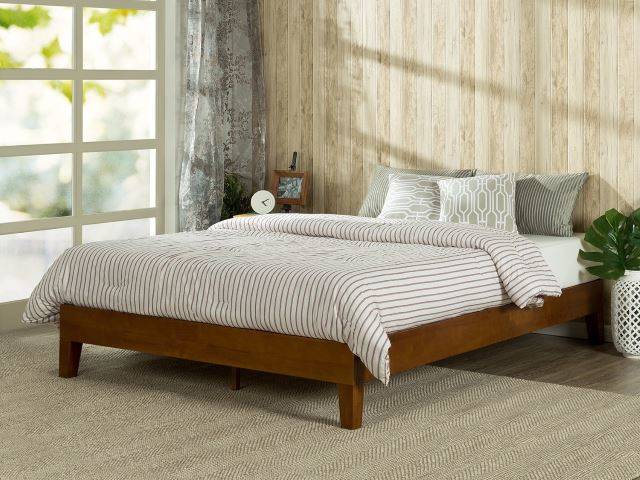The Platform Bed: Excellent Support for Your Mattress Choices
If you have been mattress shopping at any point in the last decade, you've probably had to ask yourself if you have provided the proper mattress support for your mattress picks. With foam materials gaining in popularity in the mattress industry, what your mattress rests upon is even more important than ever to keep your mattress in warranty, and providing the lasting comfort you purchased it for.
Foam (and certain other types) mattresses require a supportive foundation to rest upon in order to keep it from breaking down and creating sags and other uncomfortable situations. When used on a traditional boxspring, they are often not supported as much as they should, and rather than provide the support you crave, eventually compress and breakdown under the pressure of the uneven foundation.
Platform beds have become the frame of choice for most mattresses due to this, and the good news for you is that they are offered in a wide variety of designs and materials to fit into any decor without having to sacrifice style.
Even I have been confused by the many new terminologies surrounding platform beds, and have broken down what, exactly, you should be looking for to help you find the best support for your mattress choices.
Table Of Contents
What is a Platform Bed?

When this question was first put forth to me I found myself unable to give a quick, easy answer. Researching for a complete solution, I realized that if you are unaware of exactly how and why a platform bed works, then you run the risk of spending good money on the wrong support, or even ruining a perfectly good mattress over time. This isn’t a complicated question, however, and if you too are getting thrown by the use of floating platform bed, low profile platform bed, or slatted platform bed- you aren’t alone, and will benefit from this quick guide to what, exactly, is a platform bed?
The quick and dirty answer to that question is that a platform bed incorporates a simple frame of usually metal or wood that offers support to ANY type of mattress without the needs of a boxspring. Often more of a low profile bed (although many newer styles are of a more traditional bed frame height), they offer either a flat, or slatted support surface upon which your mattress rests.
There are a few defining characteristic that you should be familiar with in order to properly know what you should be looking for when on your search for one. This is especially true of your online shopping experience that often utilizes terminology that may look confusing upon first glance.
What Is a Low Profile Platform Bed

As mentioned, traditional platform beds are of a lower profile, often standing less than 12 inches in height. Generally the newer designs fall somewhere between 10 and 18 inches tall, but this is an important measurement to take note of- especially if you use the space under your bed for storage.
A lower profile can also be problematic for anyone who suffers from disabilities and needs a height more conducive to their height and possible physical weaknesses. This does not mean that you cannot place a boxspring upon a lower profile platform. This can help raise a low profile significantly, plus many boxsprings can also support a bunky board, a board made to help convert existing beds for mattresses requiring a platform support.
Little or No Clearance

Platform beds often have very little to no clearance beneath the bed, and occasionally are completely boxed in. Those that do have clearance may only have a few inches, so be sure to make note of measurements and also measure your storage solutions if you are in need of that space.
Storage solutions may be built into certain designs due to this, so if you are in search of a platform that can accommodate storage, look for those with built in drawers and shelves to help solve your space issues.
What is a Floating Platform Bed?
You may come across this term in your platform frame search, and all it is describing is a design that uses a center bed support rather than the more traditional leg frame support. This allows the bed to look as if it is floating. With these types of designs you will be hard pressed to find any with space for storage.
Head and Footboards

Traditionally platform beds do not use a head or footboard, but with a gain in popularity, and a need for better mattress support, more and more companies are providing styles that incorporate this traditional bed frame style. Headboards in particular can more often be found, with some including both. Other simple platform frames may be sold without, but have the capability to attach your own.
Just be aware that with a lower platform frame, if you have a head and foot board addition and plan on using a boxspring and mattress combination, you may end up covering up the majority of both.
What is a Solid Platform Surface?

A solid surface support is just that- a flat board with, or without, small slits to provide airflow. Others may incorporate small holes as well since foam mattresses do not always redistribute body moisture well without proper ventilation.
These flat, solid surfaces can occasionally change the feel of your mattress as well to make it a more firm support. This is especially true of anyone who has a heavier body and compresses the material more. Be sure to try your mattress out with a solid support in advance if this is the type of bed frame you plan on using.
What is a Slatted Platform Bed?

Slatted surfaces are the more popular of the two surface supports, and is comprised of a series of spaced wooden slat that generally fall between 2 and 3 inches from one another to provide the proper support for your mattress, without sacrificing comfort or breathability.
These slats are only effective if placed close enough together, so be sure to look for spacing prior to purchase. Often, if you feel they support is not good enough, you can add additional slats with a quick trip to the local hardware store.
Woven Metal

There also is a woven metal support available on the market, but it has been found to not always be ideal due to how much pressure it can put upon foam over time. The narrow guage of the metal often is unable to distribute weight well and can cause long-term damage to certain types of foam. However, these types of supports can work well with a boxspring, and many hybridized or innerspring mattress choices.
Cross Sectional Supports
This is important as all platform beds larger than a twin should have a cross sectional support, Many times this means there is a bar running down the center length of the bed with one to three additional supportive legs. Other beds may have both a support running the length, and width.
Either way, if your platform doesn’t have this, then you most likely want to avoid that frame as over time you will find your mattress sagging as the platform surface begins breakdown under regular use.
These supports can also hinder your underbed storage, and almost always a lengthwise support is more than enough to keep your mattress level and supportive through the years you own it.
Conclusion
Trying to find the perfect platform bed doesn’t have to be a hassle, nor do you have to end up with something you don’t like. Just be aware of the terminology that surrounds what a platform bed is, and keep in mind that most foam constructed mattresses nowadays needs this sort of support.
If you have any further questions, please let us know below. And happy platform hunting!
Related Posts
Platform vs Panel Beds: Best Practical Support for Your Decor
The Best Platform Beds for a Casper Mattress
Floyd Platform Bed Review
Best Platform Beds: 11 Choices to Fit Your Decor
Baxton Studio Platform Bed Reviews
Zinus Platform Bed Reviews: 5 of Their Top Choices to Consider
Platform bed Slats vs Solid: Your Best Platform Bed Choices
What Is The Best Murphy Bed Out There?
